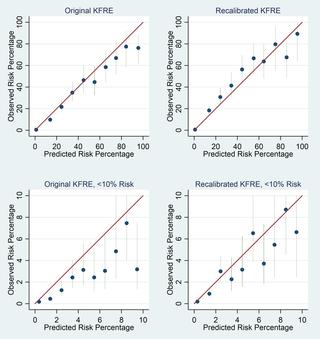Our official English website, www.x-mol.net, welcomes your
feedback! (Note: you will need to create a separate account there.)
The Kidney Failure Risk Equation for prediction of end stage renal disease in UK primary care: An external validation and clinical impact projection cohort study.
PLOS Medicine ( IF 10.5 ) Pub Date : 2019-11-06 , DOI: 10.1371/journal.pmed.1002955 Rupert W Major 1, 2, 3 , David Shepherd 1 , James F Medcalf 2 , Gang Xu 2, 4 , Laura J Gray 1 , Nigel J Brunskill 2, 4
PLOS Medicine ( IF 10.5 ) Pub Date : 2019-11-06 , DOI: 10.1371/journal.pmed.1002955 Rupert W Major 1, 2, 3 , David Shepherd 1 , James F Medcalf 2 , Gang Xu 2, 4 , Laura J Gray 1 , Nigel J Brunskill 2, 4
Affiliation

|
BACKGROUND
The Kidney Failure Risk Equation (KFRE) uses the 4 variables of age, sex, urine albumin-to-creatinine ratio (ACR), and estimated glomerular filtration rate (eGFR) in individuals with chronic kidney disease (CKD) to predict the risk of end stage renal disease (ESRD), i.e., the need for dialysis or a kidney transplant, within 2 and 5 years. Currently, national guideline writers in the UK and other countries are evaluating the role of the KFRE in renal referrals from primary care to secondary care, but the KFRE has had limited external validation in primary care. The study's objectives were therefore to externally validate the KFRE's prediction of ESRD events in primary care, perform model recalibration if necessary, and assess its projected impact on referral rates to secondary care renal services.
METHODS AND FINDINGS
Individuals with 2 or more Chronic Kidney Disease Epidemiology Collaboration (CKD-EPI) eGFR values < 60 ml/min/1.73 m2 more than 90 days apart and a urine ACR or protein-to-creatinine ratio measurement between 1 December 2004 and 1 November 2016 were included in the cohort. The cohort included 35,539 (5.6%) individuals (57.5% female, mean age 75.9 years, median CKD-EPI eGFR 51 ml/min/1.73 m2, median ACR 3.2 mg/mmol) from a total adult practice population of 630,504. Overall, 176 (0.50%) and 429 (1.21%) ESRD events occurred within 2 and 5 years, respectively. Median length of follow-up was 4.7 years (IQR 2.8 to 6.6). Model discrimination was excellent for both 2-year (C-statistic 0.932, 95% CI 0.909 to 0.954) and 5-year (C-statistic 0.924, 95% 0.909 to 0.938) ESRD prediction. The KFRE overpredicted risk in lower (<20%) risk groups. Reducing the model's baseline risk improved calibration for both 2- and 5-year risk for lower risk groups, but led to some underprediction of risk in higher risk groups. Compared to current criteria, using referral criteria based on a KFRE-calculated 5-year ESRD risk of ≥5% and/or an ACR of ≥70 mg/mmol reduced the number of individuals eligible for referral who did not develop ESRD, increased the likelihood of referral eligibility in those who did develop ESRD, and referred the latter at a younger age and with a higher eGFR. The main limitation of the current study is that the cohort is from one region of the UK and therefore may not be representative of primary care CKD care in other countries.
CONCLUSIONS
In this cohort, the recalibrated KFRE accurately predicted the risk of ESRD at 2 and 5 years in primary care. Its introduction into primary care for referrals to secondary care renal services may lead to a reduction in unnecessary referrals, and earlier referrals in those who go on to develop ESRD. However, further validation studies in more diverse cohorts of the clinical impact projections and suggested referral criteria are required before the latter can be clinically implemented.
中文翻译:

肾脏衰竭风险方程式,用于预测英国初级保健中的终末期肾脏疾病:一项外部验证和临床影响预测队列研究。
背景肾衰竭风险方程(KFRE)使用年龄,性别,尿白蛋白/肌酐比(ACR)和估计的慢性肾病(CKD)患者肾小球滤过率(eGFR)的4个变量来预测风险2至5年内末期肾脏疾病(ESRD)的发生,即需要透析或进行肾脏移植。目前,英国和其他国家/地区的国家指南编写者正在评估KFRE在从初级保健到二级保健的肾脏转诊中的作用,但是KFRE在初级保健中的外部验证有限。因此,该研究的目的是从外部验证KFRE对初级保健中ESRD事件的预测,必要时进行模型重新校准,并评估其对二级保健肾服务转诊率的预期影响。方法和发现2004年12月1日至2004年之间,有两次或更多次慢性肾脏病流行病学协作(CKD-EPI)eGFR值<60 ml / min / 1.73 m2且间隔90天以上且尿液ACR或蛋白与肌酐比值测量的个体队列中包括2016年11月1日。该队列包括来自630,504名成年人的总人口中的35,539(5.6%)个人(女性57.5%,平均年龄75.9岁,CKD-EPI eGFR中位数51 ml / min / 1.73 m2,ACR中位数3.2 mg / mmol)。总体而言,在2年和5年内分别发生了176(0.50%)和429(1.21%)个ESRD事件。中位随访时间为4.7年(IQR 2.8至6.6)。对于2年(C统计0.932,95%CI 0.909至0.954)和5年(C统计0.924,95%0.909至0.938)ESRD预测,模型判别均非常出色。KFRE预测风险较低(< 20%)的风险人群。降低模型的基准风险可以改善较低风险组的2年和5年风险的校准,但会导致较高风险组的风险被低估。与目前的标准相比,使用基于KFRE计算的5年ESRD风险≥5%和/或ACR≥70mg / mmol的推荐标准,减少了没有发展ESRD的符合推荐条件的个体数量,确诊为ESRD并在更年轻且eGFR较高的情况下转诊ESRD的人是否具有转诊资格的可能性。当前研究的主要局限性在于该队列来自英国的一个地区,因此可能无法代表其他国家的CKD初级保健。结论在该队列中,重新校准的KFRE准确预测了初级保健2年和5年时ESRD的风险。将其引入初级保健中转诊至二级保健肾服务可能会减少不必要的转诊,并减少那些继续发展ESRD的人的早期转诊。但是,在临床实施预测的更多样化队列中,还需要进行进一步的验证研究,并提出推荐的转诊标准,才能在临床上实施后者。
更新日期:2019-12-03
中文翻译:

肾脏衰竭风险方程式,用于预测英国初级保健中的终末期肾脏疾病:一项外部验证和临床影响预测队列研究。
背景肾衰竭风险方程(KFRE)使用年龄,性别,尿白蛋白/肌酐比(ACR)和估计的慢性肾病(CKD)患者肾小球滤过率(eGFR)的4个变量来预测风险2至5年内末期肾脏疾病(ESRD)的发生,即需要透析或进行肾脏移植。目前,英国和其他国家/地区的国家指南编写者正在评估KFRE在从初级保健到二级保健的肾脏转诊中的作用,但是KFRE在初级保健中的外部验证有限。因此,该研究的目的是从外部验证KFRE对初级保健中ESRD事件的预测,必要时进行模型重新校准,并评估其对二级保健肾服务转诊率的预期影响。方法和发现2004年12月1日至2004年之间,有两次或更多次慢性肾脏病流行病学协作(CKD-EPI)eGFR值<60 ml / min / 1.73 m2且间隔90天以上且尿液ACR或蛋白与肌酐比值测量的个体队列中包括2016年11月1日。该队列包括来自630,504名成年人的总人口中的35,539(5.6%)个人(女性57.5%,平均年龄75.9岁,CKD-EPI eGFR中位数51 ml / min / 1.73 m2,ACR中位数3.2 mg / mmol)。总体而言,在2年和5年内分别发生了176(0.50%)和429(1.21%)个ESRD事件。中位随访时间为4.7年(IQR 2.8至6.6)。对于2年(C统计0.932,95%CI 0.909至0.954)和5年(C统计0.924,95%0.909至0.938)ESRD预测,模型判别均非常出色。KFRE预测风险较低(< 20%)的风险人群。降低模型的基准风险可以改善较低风险组的2年和5年风险的校准,但会导致较高风险组的风险被低估。与目前的标准相比,使用基于KFRE计算的5年ESRD风险≥5%和/或ACR≥70mg / mmol的推荐标准,减少了没有发展ESRD的符合推荐条件的个体数量,确诊为ESRD并在更年轻且eGFR较高的情况下转诊ESRD的人是否具有转诊资格的可能性。当前研究的主要局限性在于该队列来自英国的一个地区,因此可能无法代表其他国家的CKD初级保健。结论在该队列中,重新校准的KFRE准确预测了初级保健2年和5年时ESRD的风险。将其引入初级保健中转诊至二级保健肾服务可能会减少不必要的转诊,并减少那些继续发展ESRD的人的早期转诊。但是,在临床实施预测的更多样化队列中,还需要进行进一步的验证研究,并提出推荐的转诊标准,才能在临床上实施后者。











































 京公网安备 11010802027423号
京公网安备 11010802027423号